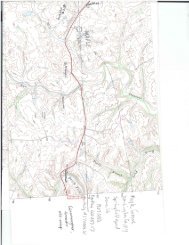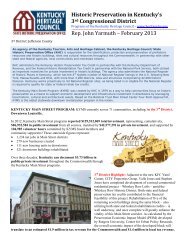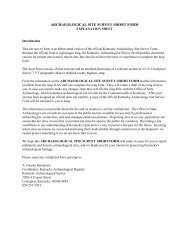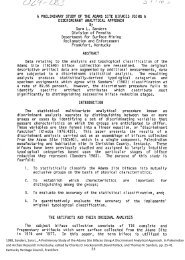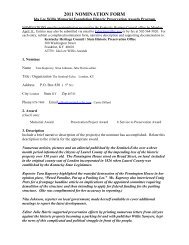Agricultural and Domestic Outbuildings in Central and Western
Agricultural and Domestic Outbuildings in Central and Western
Agricultural and Domestic Outbuildings in Central and Western
Create successful ePaper yourself
Turn your PDF publications into a flip-book with our unique Google optimized e-Paper software.
4<br />
Fenc<strong>in</strong>g, from the <strong>Western</strong><br />
Farmer’s Almanac (1835). In the<br />
background, a large farmhouse,<br />
stacks of hay, <strong>and</strong> a smokehouse<br />
are visible.<br />
OUTB OUTBUILDINGS OUTB OUTB UILDINGS IN IN CENTRAL CENTRAL & & WESTERN WESTERN WESTERN KENTUCKY<br />
KENTUCKY<br />
KENTUCKY<br />
the occasional s<strong>in</strong>khole. As could be imag<strong>in</strong>ed, settlement was more<br />
rapid <strong>in</strong> areas with better quality soils. The Inner Bluegrass, then,<br />
was peopled first, followed by the other regions based upon the potential<br />
for productive agriculture. It follows that the rate of settlement<br />
was not uniform for all of Kentucky. The time period <strong>in</strong> which farmers<br />
were able to make a comfortable liv<strong>in</strong>g depended largely on when<br />
a settler arrived <strong>in</strong> Kentucky <strong>and</strong> <strong>in</strong> what region he/she obta<strong>in</strong>ed l<strong>and</strong>:<br />
these factors <strong>in</strong> turn affected the types of build<strong>in</strong>gs they constructed.<br />
Thus, the late settlement <strong>and</strong> antebellum time frames are used to show<br />
a general sketch of farm<strong>in</strong>g <strong>in</strong> central <strong>and</strong> western Kentucky.<br />
The Late Settlement Period<br />
Farm<strong>in</strong>g <strong>in</strong> the first decades of the n<strong>in</strong>eteenth century was, <strong>in</strong> general,<br />
at the subsistence level. The early farmer had much work to accomplish<br />
before the l<strong>and</strong> could reach even partial productivity. The first<br />
task that farmers <strong>in</strong> all regions of Kentucky faced was clear<strong>in</strong>g the<br />
l<strong>and</strong> of trees <strong>and</strong> brush. This could be a very arduous undertak<strong>in</strong>g.<br />
Trees had to be girdled, that is, the bark <strong>and</strong> the cambium had to be<br />
cut away, <strong>in</strong> order to kill the tree. Then, the roots had to be cut <strong>and</strong> the<br />
stumps pulled up. It could take several years of hard physical labor to<br />
prepare a medium sized lot for cultivation. In the meantime, farmers<br />
grew small plots of corn, beans, <strong>and</strong> squash for their own consumption.<br />
Game caught <strong>in</strong> wooded areas, along with various breads, provided<br />
the rema<strong>in</strong>der of their sustenance. (Harrison <strong>and</strong> Klotter 1997,<br />
137).<br />
Fenc<strong>in</strong>g was also a priority dur<strong>in</strong>g this period. From trees removed<br />
from the fields, farmers shaped <strong>and</strong> placed wooden fenc<strong>in</strong>g around<br />
the perimeter of their hold<strong>in</strong>gs. More fenc<strong>in</strong>g followed, enclos<strong>in</strong>g<br />
crop fields <strong>and</strong> pastures as they were improved. In early Kentucky,<br />
fences were used to keep stock from w<strong>and</strong>er<strong>in</strong>g off the property <strong>and</strong><br />
from destroy<strong>in</strong>g agricultural yields. Bourbon County tenant farmer<br />
Mart<strong>in</strong> Davis wrote to l<strong>and</strong>owner Green Clay, of Madison County,<br />
about this difficult process <strong>in</strong> 1825, “We are all well <strong>and</strong> at work on<br />
our fence as hard as<br />
we can I have got<br />
about 3 hundred<br />
paniels done ten rales<br />
high I am determen to<br />
have the best fence <strong>in</strong><br />
the nabourhood before<br />
I quiet” (Murray-<br />
Wooley <strong>and</strong> Raitz<br />
1992, 111).



